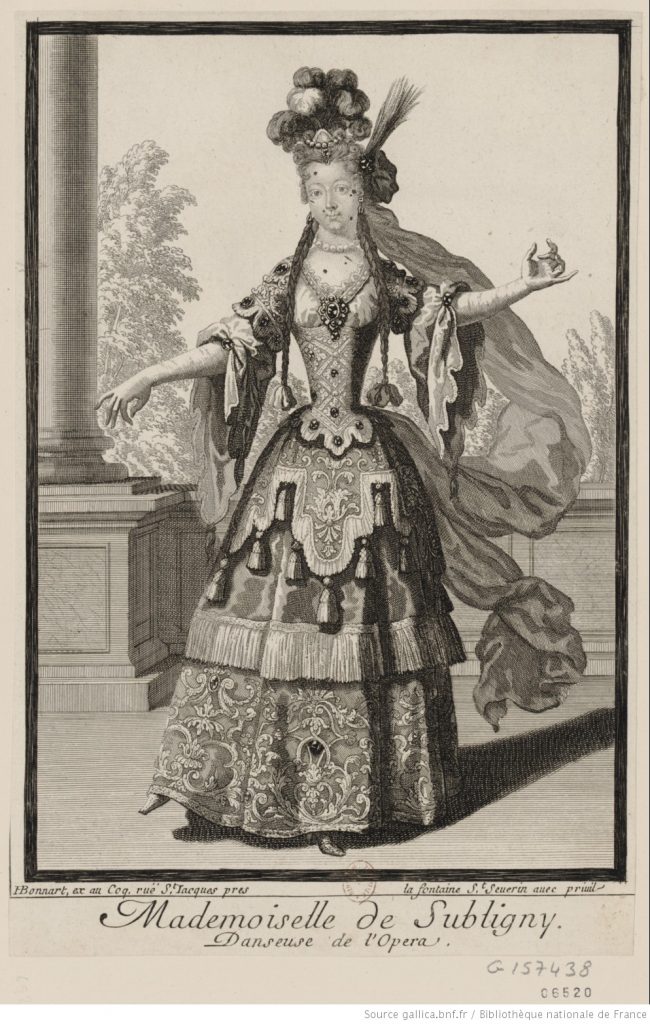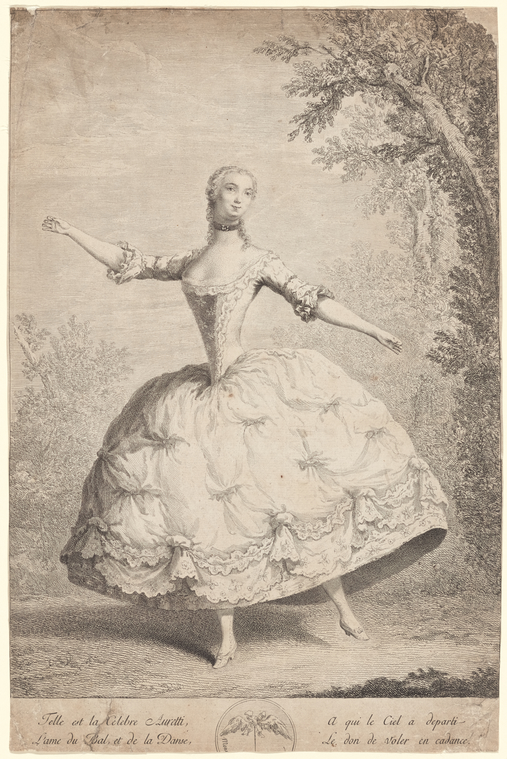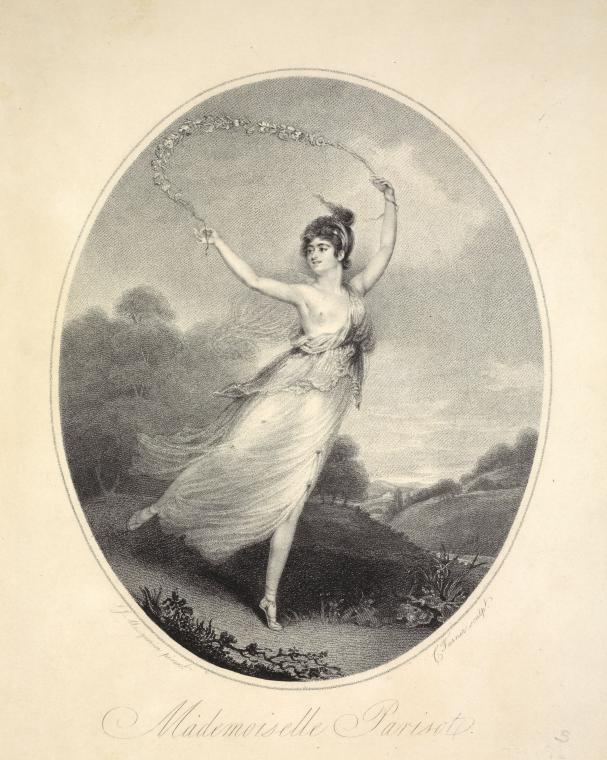JENNIFER THORP
Marie-Thérèse Perdou de Subligny was born in July 1666 in Paris, daughter of the author and playwright Adrien-Thomas Perdou, sieur de Subligny (1636-1696). The first reference we have to her as a member of the Paris Opéra dance troupe dates from April 1687 when the architect Nicodemus Tessin saw her dance in a performance of Lully’s Persée. He thought she was one of the best female dancers there, and even described her exquisite costume: ‘The underskirt was made of gold moiré, with a blue and silver embroidered border all round. It was the same for the overskirt, which came to the knee. Around the bottom of the under-petticoat of gold moiré, there were fairly widely spaced bands of black braid, resembling velvet and bordered with silver. Near the top, the sleeves were slashed, then tight-fitting, and open lower down’ (1).

Research by Nathalie Lecomte and Rebecca Harris-Warrick has corrected several errors in the existing biographies and dictionary articles on Subligny. There is, for instance, uncertainty about exactly what and when she danced in her early years at the Opéra because female dancers were not named in the livrets before 1699. Twentieth-century biographers all tended to follow Émile Campardon’s entry for Subligny in his L’Académie Royale de Musique au XVIIIe Siècle (Paris, 1884, vol. 2, pp. 295-297), and thereby were misled into assuming that, because she is known to have danced in post-1699 revivals of certain operas, she therefore must also have danced in the original staging, yet this is by no means certain and both the choreographies and the performers may well have changed before 1699.
Subligny is first mentioned in the opera livrets as dancing in the 1699 revival of Jean Baptiste Lully’s Proserpine, as one of the ‘Ombres heureuses’ (happy spirits) of the underworld in Act IV. Also in 1699, Henri Bonnart published an engraving of ‘Mademoiselle Subligny Danseuse de l’Opéra, and around the same time Jean Mariette published another, of ‘Mademoiselle Subligny dansant à l’Opéra’ (2).

Subligny’s skills in different dance styles are borne out by the number of solos she danced subsequently in Paris (3). By the time she retired from the stage she was one of the highest paid female dancers at the Opéra and had performed in at least six Lully operas and in revivals of such works as the Ballet des Fragments de Mr de Lully, and André Campra’s L’Europe galante, often as the dance partner of Claude Balon (1671-1744). Her last known performance before retiring was on 26 November 1705, dancing a solo as a Nymph of Diana and a duet with Balon in Le Triomph de l’Amour (4).
The surviving dances for Subligny comprise four theatrical solos and twelve duets with Claude Balon. All were created by the Opéra’s ballet-master of their day, Guillaume-Louis Pécour, and survive because they were published in notation by Raoul-Auger Feuillet (L’Allemande in 1702, inspired by a Balon-Subligny duet, followed by ten more duets and three solos in his Recueil de dances contenant […] des meilleures Entrées de Mr Pecour in 1704), and by yet another duet and one solo published by Michel Gaudrau (in his Nouveau recueil de danse […] de Ballet in 1713). All were set to music from operas and opera-ballets by Lully, Campra, André Cardinal Destouches, and Theobaldo di Gatti (5).
Two of the solos specify that Subligny danced them ‘en Angleterre’, and she is believed to be the first leading female dancer from Paris to perform on the London stage. Robert D. Hume’s proposal that she was in London in December 1701 is now challenged by Lecomte’s findings that Subligny could not have reached London before late-January 1702, for she had been in Paris, dancing in Destouche’s Omphale, between 10 November and 8 January, and in a new version of Gatti’s Scylla from 20 December until 10 January (but not in its Versailles Trianon performance on 27 February) (6). Nor could she have remained in London much beyond March or early April, as more Omphale performances after Easter and rehearsals for Acis & Galatea (due to open in June) required a return to Paris. As will be discussed presently, Subligny was mentioned in the London publication A Comparison between the Two Stages, a critical discourse presented as a dialogue ‘between Ramble and Sullen, two gentlemen, and Chagrin a critick’ which was published on 14 April 1702 but probably compiled in February and March (7).
For a dancer who spent such a short time in London, Subligny made a remarkable impact. The charms of ‘gallick heels’ were blamed for wrecking the revival of Farquhar’s play The Inconstant at Drury Lane in February 1702 because audiences preferred to go and see the ‘French lady’ dance at Lincoln’s Inn Fields (8). Subligny was described, in A Comparison between the Two Stages, as ‘a new wonder’ whose footwork became a near-obsession for ‘gentleman’ Ramble (p. 67 – it is he who ‘long[s] to be ogling Madam’s feet’); the critic Chagrin, however, thought her a ‘surprising monster’ (p. 67). The only two solos that we know she danced in London were the Gigue pour une femme (to music from Gatti’s Scylla), which may or may not have been adapted from the Paris version (1701), and a Passacaille pour une femme to music from Lully’s Armide, which perhaps was destined to be modified for inclusion in the new Paris version of that opera in 1703. Otherwise, we shall probably never know exactly what she danced in London, as no copy of Walsh’s Second Book of the Gentleman’s Companion …for the flute…To which are added several new French Dances perform’d by Mlle de Subligny (advertised in the Post Boy 25-28 April 1702) is known to have survived. His naming of a female dancer of renown in one of his own music publications was perhaps an early sign of his commercial acumen in trying to be the first to present new talent or newsworthy musical events to the public.
The comment in the Biographical Dictionary of Actors that Subligny arrived in London with a letter of introduction to the philosopher John Locke does not imply that they actually met (9). Given that her father was a writer, and that Locke had spent some time in Paris in the 1670s, it would not have been unusual for Subligny to carry such a letter, but by 1702 the now very elderly Locke had long retired to High Laver in Essex, and it seems unlikely that Subligny would have had time to make a journey out of London to visit him.
Subligny lived on for another thirty years after her own retirement, dying in c.1735. It is a pity that more is not known of her career, which was halfway over by the time she started to be widely documented as a dancer. In Paris, younger female dancers such as Mademoiselle Guiot were already making a name for themselves, their own careers no doubt helped by Subligny setting a high standard by her performance skills. In London, however, responses to her varied: Thomas Betterton, the Lincoln’s Inn Fields theatre manager, deplored the expensive fee that she was able to command, but the public flocked to see her perform (10), and the beauty and ingenuity of her surviving dances still continue today to bear witness to her skills.
Notes
- Caroline Wood and Graham Sadler, French Baroque Opera: A Reader (Aldershot: Ashgate, 2000),126.
- Editor’s note: These are early examples of portraits depicting a performer rather than a member of the social élite: Bonnart had previously drawn King James II; Mariette’s earlier work included a portrait of a more typical subject in Louise de Kéroualle, Duchess of Portsmouth.
- See Rebecca Harris-Warrick, Dance and Drama in French Baroque Opera (Cambridge: Cambridge University Press, 2016), 384.
- Nathalie Lecomte, Entre cours et jardins d’illusion: le ballet en Europe 1515-1715 (Paris: Centre National de la Danse, 2014), 342-3. Also personal communications.
- See catalogue descriptions in Meredith Little and Carol Marsh, La Danse Noble, an Inventory of Dances and Sources (New York: Broude Bros, 1992); Francine Lancelot, La Belle dance, catalogue raisonné (Paris: Van Dieren, 1996).
- Robert D. Hume, “A Revival of The Way of the World in December 1701 or January 1702”, Theatre Notebook 26 (1971), 30-36; for Lecomte, see n4 above.
- Anonymous, A Comparison between the two Stages, with an Examen of The generous Conqueror; and some critical Remarks on The funeral, or Grief alamode, The false friend, Tamerlane and others. In dialogue (London : [s.n.], 1702). Hume (as in n. 6, p. 30) notes the date of publication as 14 April 1702, without citing a source. The London Post of 8 May 1702 described it as ‘lately Publish’d’.
- George Farquhar, The Inconstant (London, 1702), preface.
- Philip H. Highfill, Jr., Kalman A. Burnim, and Edward Langhans, A Biographical Dictionary of Actors, Actresses, Musicians, Dancers, Managers and other stage Personnel in London 1660-1800, vol. 14 (1991), 329.
- Betterton would later blame ‘the Depravity of the Taste of the Audience’ for obliging him ‘on Account of Self-defence’ to keep on bringing in foreign and expensive stars who included Subligny, followed by Balon and L’Abbé: see Charles Gildon, The Life of Mr Thomas Betterton (London, 1710), 142-3, 155. John Downes had made a similar observation two years earlier: John Downes, Roscius Anglicanus (London, 1708), 96-97.
Images
- 1) Bonnart, Henri,1642-1711 (engraver),“Mademoiselle de Subligny, Danseuse de l’Opéra”. Paris, La Fontaine, St Sépulchre, 1699. Engraving. Source: Source gallica.bnf.fr / BnF. https://gallica.bnf.fr/ark:/12148/btv1b84073913. Public domain.
- 2) Mariette, Jean, 1660-1742 (engraver). “Mademoiselle Subligny dansant à l’Opéra.” Paris, Chez J. Mariette, rue St. Jacques aux Colonnes d’Hercule [169-?]. Engraving. From the New York Public Library. http://digitalcollections.nypl.org/items/510d47e2-0c52-a3d9-e040-e00a18064a99. Public domain.
Next post
‘The reputation of the dancer Nancy Dawson’ part 1 of 2, by Olive Baldwin and Thelma Wilson. To be published 24 August 2021.

